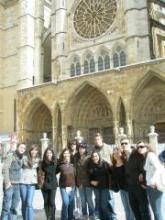[raw]
This was a telecollaborative exchange which took place from 2005 to 2011 between the University of León, Spain and Barnard College, New York. The project combined stages of online intercultural exchange with stages of physical mobility between the two classes. After initial online interaction, a group of students from León would travel to New York and would take part in classes with the American group for one week. Following that, the American group came to Spain to participate in classes with the Spanish class for another week. The exchange would then return to online interaction between the two classes. The content of the online interaction and the project work carried out during the physical mobility was all stored on a wiki.
Main Focus:
Intercultural Exchange
Exchange institution(s):
University of León
Project website:
The Spanish-American Cultura Exchange
Language Configurations:
Bilingual
Language(s) used:
| English |
|---|
| Spanish |
Dominant form of language production:
Writing/reading synchronous
Target Competences:
| Language Comptence |
|---|
| Intercultural Skills |
Replicability:
The online part of this exchange was based on the Cultura exchange model which can be easily reproduced. Below you can find a presentation from an academic conference about the exchange (IALIC2005) and also some screen shots from the wiki used to house the exchange.
How long did the project last?
The project lasted one full semester each year. This involved 6-8 weeks of online contact and project work and 2 weeks of time abroad in the two participating institutions.
How was the project organized?
The project followed the following format:
Students in both classes create introductory videos about their home towns.
Students create autobiographies in the target language.
Students complete and analyse ‘ Cultura’ style questionnaires in their classes. They then discuss these questionnaires online together in asynchronous discussion forums.
Tasks:
| Cultura Questionnaires |
|---|
| Local culture presentation |
Task types:
The online exchange is based on the completion and analysis of Cultura comparative questionnaires. This activity is complemented by the creation of videos, autobiographies and essays. All the materials are shared on the project wiki.
How were the students assessed?
The students were assessed based on their work during the course. They received marks for their introductory videos, their autobiographies and their final essays. They also received marks for consistent participation in the project forums.
Additional resources:
Here are some example videos made by students participating in the project:
http://www.youtube.com/watch?v=6rBF9ACkTFM list=PL7C67DFE6F38BA5AE index=1
What worked well?
The combination of physical and virtual mobility was obviously very popular among the students. Each group received funding to cover their flights to the other country and accommodation was also covered. This meant that students could spend one week with the partner class more or less free of charge. The fact that students could first of all get to know their partners online before actually travelling and working together was also very positive.
What did students think of the project?
What challenges did you face?
Both organising teachers needed to ask their respective institutions for funding to cover the students’ flights. In the case of Barnard, the teacher also needed to ask for free accommodation for the visiting Spanish group.
What did the teachers think of the project?
What kind of institutional support did you receive?
The financial support to enable the physical mobility stage was vital to the excess of the exchange.

